#arnolds diary entries
Text
Arnold's Diary Entry 01
Today, I went to visit Ella the Harpy's bookshop to confirm the prophecy of the quest for Lady Diana. The fact that while the legion was busy searching into the increased monster population and sending teams at the skirts of Mt Othrys the Greek demigods were there, right next to us, saving Lady Diana from Atlas and the Titan army. Makes me wonder how many opportunities for the two camps to meet.
On the way back I came across Pranjal, who was going to post a few packages to some friends. Upon sight, he told me he didn't know why the confiscated files on the Titan army medics were destroyed. Rude. I didn't even ask him this time. Though; maybe I should buy him coffee later to apologise for pestering him repeatedly.
#arnolds diary entries#hoo#new rome#camp jupiter#pranjal toa#pjo#[rp/ask blog]#pjo oc#ella the harpy
7 notes
·
View notes
Text
Identity V The Animation "Arnold and Puppets"
Main Character Introduction

Arnold Krebreg, Manager of the Kraevif Theater
Arnold was inspired to create this puppet show from a diary he happened to find. He created small dolls with unique designs based on the entries in the diary, giving each one of the puppets a different personality. Then, at the Kraevif Theater, he will present a puppet show in which the love and hate of the puppets are intertwined. Dear audience, please come see him!

Puppet Joker, The main character
The selfish, greedy, and sometimes playful Joker is the main character of this puppet show. Full of interesting ideas, he causes various events and brings a cheerful daily life to the manor.

Puppet Leo, A good man with a kind heart
Leo is always kind and friendly. He takes his work very seriously, but once he gets angry, his ferocious and dark side appears!

Puppet Bane, A giant man who looks wild but is kind on the inside
Bane is quiet and kind, and he loves cooking. He loves to serve the food he has cooked, but his lack of common sense can sometimes cause Joker and Leo to get into a lot of trouble.
#idv#identity v#arnold and puppets#idv arnold#arnold krebreg#idv smiley face#idv joker#idv hell ember#leo beck#idv gamekeeper#bane perez
9 notes
·
View notes
Text
an unsolicited rant about moviefilms by me
when people find out i was a theatre major they always want to talk to me about film. to me this feels like if i told someone i speak french and their response was "oh cool so you understand spanish?" and it's like no dude. what i love is theatre. film is its own, different thing that i know fuck all about. i also honestly dislike a lot of movies that are considered good/cool/classics. i don't enjoy popular american movies in general. like i hate pulp fiction and fight club and all such tryhard fakedeep hollywood garbage. i also strongly dislike wes anderson and quentin tarantino is the worst. also larry clark and gus van sant are simply awful.
but to be clear there ARE plenty of films i love. my favorite movies are aguirre, wrath of god eraserhead, the 400 blows and ratcatcher and this film called fishtank by andrea arnold. i love lynne ramsay and the cohen brothers have some hits like barton fink. and charlie kaufman is usually pretty wonderful. and i like darren aronofsky too for the most part. oh and tarkovsky forever and ever; the mirror lives deep in my heart. there's also this movie called come and see by elem klimov that's really important. and i appreciate harmony korine's willingness to experiment and take risks and make different kinds of films. i don't like everything he's made, but i think he rocks as an artist. julien donkey-boy is one of my all-time favorites and i love mister lonely too. sofia coppola is actually ok with me for reasons i cannot fully articulate. that marie antoinette movie is my guiltiest pleasure lol and do not get me started on emma watson's brilliant and criminally underrated performance in the bling ring. i also like 3 women and who's afraid of virginia woolf and russian ark. buffalo '66 was cool and so was la haine. and fucking days of heaven; terrence malick is top notch. anywayyy i need to try to accomplish something besides internet diary entries today, so this concludes today's rant no one cares about/list of shit i like. summary/tldr: my theatre education does not qualify me to discuss film, and also i like some movies but dislike others. thank you for your attention and yes this will definitely be on the test.
#personal#shit no one cares about#they should make more movies that don't suck immeasurably#i didn't mention documentaries bc we'd be here for another three paragraphs. i also didn't get into shit i liked as a kid bc#that's a waste of time for another day
6 notes
·
View notes
Photo

Rosa Mayreder - photograph - 1905
Rosa Mayreder (née Obermeyer; 30 November 1858, in Vienna – 19 January 1938, in Vienna) was an Austrian freethinker, author, painter, musician and feminist. She was the daughter of Marie and Franz Arnold Obermayer who was a wealthy restaurant operator and barkeeper.
Rosa had twelve brothers and sisters and although her conservative father did not believe in the formal education of girls he allowed her to participate in the Greek and Latin lessons of one of her brothers. She also received private instruction in French, painting and the piano.
Rosa Obermeyer was born on 30 November 1858. Her father was Franz Arnold Obermayer, who was the owner of a prosperous tavern. Accounts of Mayreder's family, social atmosphere, and insights to her personality are recorded in a series of diary entries, the first of which is dated 28 April 1873; she was fourteen at the time. Her autobiographical diary entries covered a range of topics from her every-day life to her feelings on war.
Growing up, Mayreder lived in a large household and received an education that was typical of the well-off. Mayreder was taught to play the piano, sing, speak French, and draw by private tutors. However, Mayreder was jealous that her less academically inclined brothers were given more educational opportunities. Later, the impact of this schooling would become evident, as Mayreder would revolt against the way girls were educated among the middle class. She criticized the sexual double standard and prostitution. At seventy, in 1928, she was recognized as an honorary citizen in Vienna. One such instance of rebellion was her decision to never wear a corset when she turned eighteen. This act of defiance was not only a social statement, but a personal dig against her mother, who believed it was a woman's duty to derive her sense of self from her husband and sons.
As she grew into adulthood, Mayreder was exposed to a plethora of artists, writers, and philosophers. One of the most influential activities on Mayreder's future were her frequent meetings with Josef Storck, Wiener Kunstgewebeschule, Rudolf von Waldheim, Friedrich Eckstein, and her brothers Karl, Julius, and Rudolf. Additionally, the writings of Nietzsche, Goethe, and Kant had a significant influence on her as well. Her exposure to people such as these allowed Mayreder to come in contact with those who acknowledged the discrepancies between men and women in society and encouraged her to pursue involvement in the sociological issues she believed in.
In 1881 Rosa married the architect Karl Mayreder, who later became rector of the technical university in Vienna. The marriage was harmonious but remained childless. In 1883 Rosa had an abortion and she also had two affairs, which she describes in detail in her diaries. Karl suffered repeated depressions from 1912 until his death in 1935.
19 notes
·
View notes
Text
Artist Report (6)
Eve Arnold born April 21st 1912 and died January 4th 2012 in Philadelphia was an American photojournalist who then went to live in the United Kingdom where she joined magnum photos in 1951 and would then go on to become a full member in 1957, she was also the first woman to join magnum photos and is most famously known for her pictures of Marilyn Monroe and some of The Misfits. She was also 1 of 9 children born to her Jewish-Russian family where she first began to study medicine, but then decided to drop it entirely for a career in photography there in 1946 she began her career working for Kodak, and using a Rolleicord to photograph her city from her perspective.
she learned photographic skills from Harper's Bazaar art director Alexey Brodovitch at the New School for Social Research in Manhattan. Studying photography under Brodovitch, she produced a collection of photos from Harlem's vivid fashion show scene. The collection was published the series in the London Illustrated Picture Post in 1951. Although the series launched her career, she later wrote in a diary entry that the editor of the magazine changed her captions and reversed the message of her photographs to fit a racist narrative. She then became interested in African American migrant workers suffering housing discrimination in Long Island.
Arnold spent time covering Republican Party press events, the McCarthy hearings, and explored the subject of birth which was taboo. She was well aware of the underrepresentation of women photojournalists and the position of women celebrities in the public eye. Arnold explored these ideas about women in her full length photo book The Unretouched Woman which was published in 1976.
Her work of Marilyn Monroe was by far her most famous pieces where she would showcase the anxieties that Monroe had felt being in the public eye
much of Arnold's work, as she took interest in photographing the Civil rights and Black power movements in the United States as well as in the rigid Soviet Union and in China. Arnold always strived to go deeper with her photography; she even returned from some shoots with cigarette burns on her clothing from a judgmental crowd. She produced a film in 1971, Women Behind the Veil, focusing on Arabian harems and hammams, and had even photographed Queen Elizabeth herself.
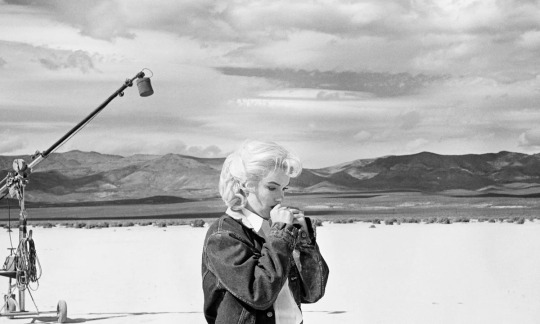
0 notes
Text
Prosecution Rests in Tax-Fraud Trial of Rev. Moon (1982)

New York Times - Arnold H. Lubasch - May 2, 1982
The prosecution has rested its case in the tax-fraud trial of the Rev. Sun Myung Moon after presenting 30 witnesses and approximately 1,000 documents.
In four weeks of presenting the evidence in Federal District Court in Manhattan, the prosecutors sought to show that Mr. Moon had deliberately failed to report more than $150,000 of personal income on his tax returns from 1973 through 1975.
Mr. Moon, the 62-year-old Korean evangelist who heads the Unification Church, contends that he had merely been holding church funds that were not subject to income taxes. Judge Reserves Decision
On Friday, after hearing arguments by both sides, Judge Gerard L. Goettel reserved his decision on a defense motion to dismiss the charges on the ground that the prosecution had failed to prove its case.
The prosecution's last witness was Dr. Herbert Rowe, a former manager of a paper-manufacturing company. Dr. Rowe said that some key church documents that were supposedly signed in 1973 were written on paper that was not manufactured until 1974.
When asked if the manufacturing date was proved by a watermark on the paper, he replied, ''That is correct.'' The disputed documents were supposed to show that foreign church funds had been deposited in Mr. Moon's bank accounts, supporting the defense view that the accounts held church funds. But the prosecution contended that the documents had been created and backdated to obstruct the tax investigation.
When the testimony ended on Thursday, Martin Flumenbaum, a prosecutor, told the judge that ''the Government rests in its direct case.'' The prosecution team of Mr. Flumenbaum, Jo Ann Harris, James R. DeVita and Joan S. Alexander could present rebuttal evidence later.
Defense to Begin Tomorrow
The defense case is scheduled to begin tomorrow. The defense lawyers are Charles A. Stillman, Andrew M. Lawler and Bernard S. Bailor, who declined to say whether they would present any witnesses.
Mr. Moon is on trial with a co-defendant, Takeru Kamiyama, a top aide charged with helping file false tax returns and obstructing the investigation.
Prosecution witnesses included Chase Manhattan Bank officials who said that Mr. Moon had deposited $1.6 million in bank accounts, mostly in cash, and a Unification Church official who acknowledged that Mr. Moon had been given $50,000 of stock in a tea-importing company formed by the church.
Former Unification Church officials, testifying reluctantly under subpoenas, identified documents concerning a Westchester County estate where Mr. Moon and his family live.
The documents showed that the church had bought the estate in 1973 for $625,000, including $361,000 from Mr. Moon's accounts at Chase Manhattan. They described the $361,000 as Mr. Moon's ''personal money'' and said he had given it to the church as a ''loan.'' 'Not Accessible' to the Church
Michael Y. Warder, another former official of the church, testified under immunity from prosecution that Mr. Kamiyama had told him that the Chase Manhattan accounts contained Mr. Moon's money and were ''not accessible'' to the church.
Mr. Warder said he had been publisher of the church newspaper, The News World, and had held many budget discussions with Mr. Kamiyama. He added that he had lied to investigators about church operations to help Mr. Moon, but that the church leader had not told him to lie.
The charges against Mr. Moon accuse him of failure to report more than $100,000 of interest from the Chase Manhattan accounts, which were in his name, and $50,000 of stock issued to him by the teaimporting company, called Tong Il Enterprises.
If convicted, he could face a prison sentence of up to five years for conspiracy and three years on each of three counts of filing false tax returns.
A jury of two men and 10 women is hearing the case.
Source: NY Times
Related links and notes below
Ronald Reagan’s Diary Entry on Moon
Monday December 24, 1984
“Senator Orrin Hatch is after me to grant clemency to the Rev. Moon. I’ve explored this & find I just can’t. I have, however, taken action to see if I can grant him a furlough over New Years. It seems that day is the holiest in that religion.”
Washington Post: Moon’s Japanese Profits Bolster Efforts in U.S. (1984)
Information on COINTELPRO
Nobusuke Kishi wrote a letter to President Reagan to get Moon released from jail; he was in for perjury, document forgery and tax evasion in 1984.
That time Bo Hi Pak got scammed
Archive of Robert Parry’s Dark Side of Rev. Moon Series
#danbury#sun myung moon#moonies#unification church#takeru kamiyama#fraud#tax fraud#legal#law#investigation#1973#1974#tong il enterprises#uc assets#michael warder#michael y. warder#kamiyama#unification church in the united states of america#unification church in japan#unification church in the united states#american church
0 notes
Text
e400 — Quadringenti
#AI to chat with yourself or a Furby, @Microsoft’s #ChatGPT investment, #AR pong, @BMW #metaverse mode Neue Klasse with Arnold, Minecraft controller & #OpenDnD OGL 1.1
Dungeons & Dragons Basic Set, photo by Michael Martine Jan 2023
Episode 400! Michael, Andy and Michael all get together for the four hundredth episode of the podcast.
Getting right down to business, the co-hosts start off with a novel use of ChatGPT, where Michelle Huang trained her GPT-3 chatbot from her younger self’s diary entries. This allowed her to converse with a younger version of…

View On WordPress
0 notes
Text
ZIEGFELD FOLLIES
April 8, 1946
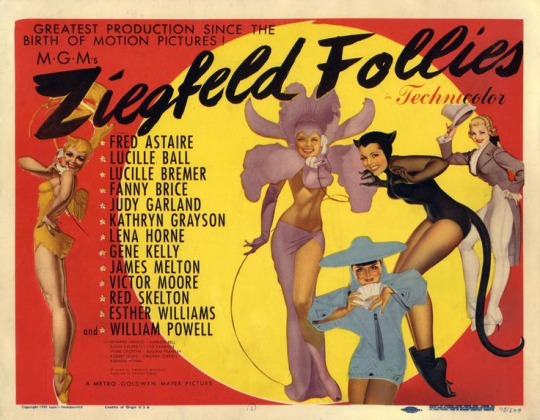
Directors: Lemuel Ayers, Roy Del Ruth. Vincente Minnelli, George Sidney,
Norman Taurog, Charles Walters. Robert Lewis
Producer: Arthur Freed for Metro Goldwyn Mayer
The shooting schedule ran between April 10 and August 18, 1944, with retakes plus additional segments filmed on December 22, 1944 and then between January 25 and February 6, 1945. The film was first proposed in 1939.
Synopsis ~ We meet a grayed, immaculately garbed Florenz Ziegfeld, Jr. in Paradise (his diary entry reads "Another heavenly day"), where he looks down upon the world and muses over the sort of show he'd be putting on were he still alive.
PRINCIPAL CAST

Lucille Ball ('Here's to the Ladies') is appearing in her 64th film since coming to Hollywood in 1933.
Fred Astaire ('Here's to the Ladies' / Raffles in 'This Heart of Mine' / Tai Long in 'Limehouse Blues’ / Gentleman in 'The Babbit and the Bromide') also appeared with Lucille Ball in Roberta (1935), Top Hat (1935), and Follow the Fleet (1936). His name was mentioned twice on “I Love Lucy.”
Lucille Bremer (Princess in 'This Heart of Mine' / Moy Ling in 'Limehouse Blues')
Fanny Brice (Norma Edelman in 'A Sweepstakes Ticket') appeared in the original stage version of many editions of The Ziegfeld Follies on Broadway.
Judy Garland (The Star in 'A Great Lady Has An Interview') also starred with Lucille Ball in Thousands Cheer (1943).
Kathryn Grayson (Kathryn Grayson in 'Beauty') also starred with Lucille Ball in Thousands Cheer (1943).
Lena Horne (Lena Horne in 'Love') also starred with Lucille Ball in Thousands Cheer (1943).
Gene Kelly (Gentleman in 'The Babbit and the Bromide') also starred with Lucille Ball in Thousands Cheer (1943), Du Barry Was A Lady (1943), and A Guide for the Married Man (1967). He made an appearance on the Lucille Ball special “Lucy Moves to NBC” (1980).
James Melton (Alfredo in 'La Traviata')
Victor Moore (Lawyer's Client in 'Pay the Two Dollars')
Red Skelton (J. Newton Numbskull in 'When Television Comes') also starred with Lucille Ball in Having Wonderful Time (1938), Thousands Cheer (1943), Du Barry Was A Lady (1943), and The Fuller Brush Girl (1950). On TV he appeared on “The Lucy-Desi Comedy Hour” in “Lucy Goes To Alaska” (1958). Ball and Skelton appeared in numerous TV specials together.
Esther Williams (Esther Williams in 'A Water Ballet') also appeared with Lucille Ball in Easy To Wed (1946).
William Powell (Florenz Ziegfeld Jr.) also played the same character in The Great Ziegfeld (1936).
Edward Arnold (Lawyer in 'Pay the Two Dollars') appeared with Lucille Ball in Roman Scandals (1933) and Ellis in Freedomland (1952).
Marion Bell (Violetta in 'La Traviata')
Cyd Charisse (Ballerina in 'Beauty') also starred with Lucille Ball in Thousands Cheer (1943).
Hume Cronyn (Monty in 'A Sweepstakes Ticket') was honored by The Kennedy Center in 1986, at the same ceremony as Lucille Ball.
William Frawley (Martin in 'A Sweepstakes Ticket') played the role of Fred Mertz on “I Love Lucy” and “The Lucy-Desi Comedy Hour”. He also appeared on “The Lucy Show,” his final screen appearance.
Robert Lewis (Chinese Gentleman in 'Limehouse Blues' / Telephone Voice in 'Number Please')
Virginia O'Brien (Virginia O'Brien in 'Here's to the Ladies') also starred with Lucille Ball in Thousands Cheer (1943), Du Barry Was A Lady (1943), and Meet The People (1944).
Keenan Wynn (Caller in 'Number Please') appeared with Lucille Ball in Easy To Wed (1946), Without Love (1945), and The Long, Long Trailer (1954).
SUPPORTING CAST
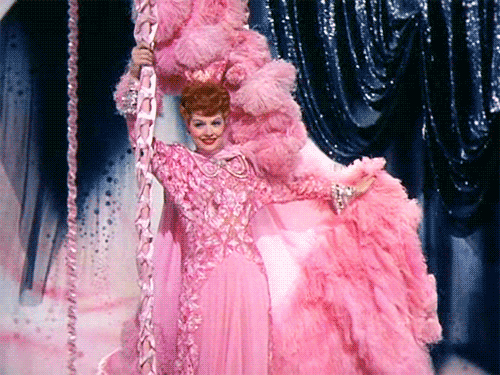
Ziegfeld Girls
Karin Booth
Lucille Casey
Aina Constant
Elizabeth Dailey
Frances Donelan
Natalie Draper
Karen X. Gaylord
Aileen Haley
Carol Haney
Shirlee Howard
Margaret Laurence
Helen O'Hara
Noreen Roth
Elaine Shepard
Kay Thompson
Dorothy Tuttle
Dorothy Van Nuys
Eve Whitney - appeared on “I Love Lucy” episode “The Charm School” (ILL S3;E15).
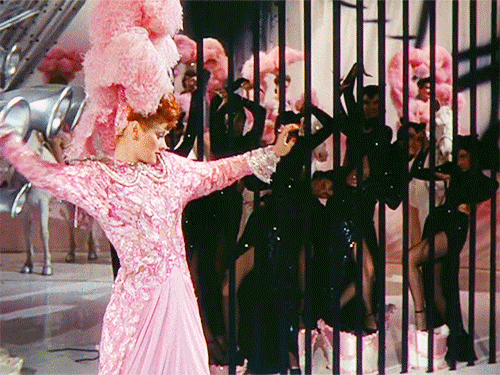
Dancers
Gloria Joy Arden
Jean Ashton
Irene Austin
Judi Blacque
Bonnie Barlowe
Norman Borine
Hazel Brooks
Ed Brown
Kathleen Cartmill
Jack Cavan
Marilyn Christine
Laura Corbay
Rita Dunn
Meredyth Durrell
Shawn Ferguson
Jeanne Francis
Jean French
Mary Jane French
David Gray
Bill Hawley
Doreen Hayward
Charlotte Hunter
Virginia Hunter
Patricia Jackson
Margaret Kays
Laura Knight
Laura Lane
Dale Lefler
Melvin Martin
Diane Meredith
Lorraine Miller
Joyce Murray
Janet Nevis
Ray Nyles
Billy O'Shay
Jane Ray
Dorothy Raye
Beth Renner
Melba Snowden
Walter Stane
Ivon Starr
Robert Trout
Chorus Boys
Rod Alexander
Milton Chisholm
Dick D'Arcy
Dante DiPaolo
Don Hulbert
Herb Lurie
Matt Mattox
Bert May - appeared on “The Lucy Show” in “Lucy and Tennessee Ernie Ford”
Jack Purcell
Tommy Rall
Ricky Ricardi (!)
Alex Romero
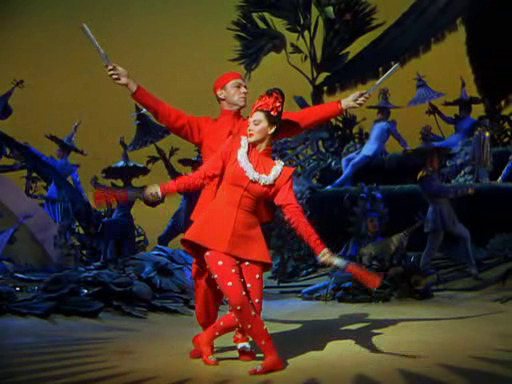
“LIMEHOUSE BLUES” starring Fred Astaire, Lucille Bremer, and Robert Lewis
Robert Ames (Masked Man)
James Barron (Couple with Banners)
Eleanor Bayley (Couple with Branches)
Mary Jo Ellis (Couple with Banners)
Sean Francis (Ensemble)
James King (Rooster)
Harriet Lee (Bar Singer)
Eugene Loring (Costermonger)
Charles Lunard (Masked Man)
Patricia Lynn (Ensemble)
Ruth Merman (Ensemble)
Garry Owen (1st Subway Policeman)
Ellen Ray (Couple with Parasols)
Jack Regas (Masked Man)
Billy Shead (Couple with Parasols)
Ronald Stanton (Couple with Branches)
Wanda Stevenson (Ensemble)
Ray Teal (2nd Subway Policeman)

“LOVE” starring Lena Horne
Juliette Ball (Club Patron)
Lennie Bluett (Dancer)
Suzette Harbin (Flirt)
Avanelle Harris (Club Patron)
Maggie Hathaway (Dancer)
Charles Hawkins (Club Patron)
Marie Bryant (Woman Getting Her Man Taken)
Cleo Herndon (Dancer)

“THIS HEART OF MINE” starring Fred Astaire and Lucille Bremer
Helen Boyce (Countess)
Feodor Chaliapin Jr. (Lieutenant)
Naomi Childers (Duchess)
Charles Coleman (Majordomo)
Sam Flint (Majordomo's Assistant)
Sidney Gordon (Masked Man)
Count Stefenelli (Count)
Robert Wayne (Dyseptic)

“PAY THE TWO DOLLARS” starring Edward Arnold and Victor Moore
William Bailey (Subway Passenger)
Joseph Crehan (1st Judge) - played a Detective on “I Love Lucy” “The Great Train Robbery”
William B. Davidson (2nd Judge)
Eddie Dunn (3rd Subway Policeman)
Harry Hayden (Warden)
George Hill (2nd Subway Policeman)
Wilbur Mack (Subway Passenger)
Larry Steers (Magistrate)
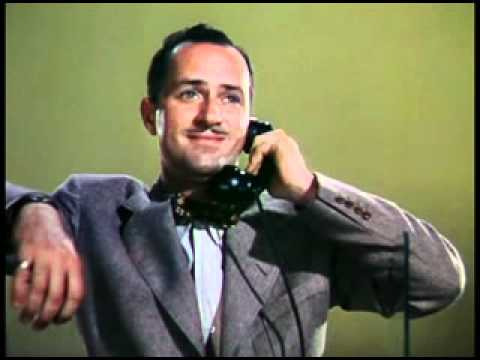
“NUMBER PLEASE” starring Keenan Wynn
Peter Lawford (Voice of Porky)
Grady Sutton (Texan)
Audrey Totter (Phone Operator Voice)
Kay Williams (Girl)
OTHERS
Bunin's Puppets
Elise Cavanna (Tall Woman)
Jack Deery (Man)
Rex Evans (Butler in "A Great Lady Has An Interview”)
Sam Garrett (Roping / Twirling Act)
Silver (Horse in "Here's to the Ladies')
Arthur Walsh (Telegraph Boy in "A Sweepstakes Ticket") - appeared on “I Love Lucy” in “Lucy Has Her Eyes Examined” (ILL S3;E11).
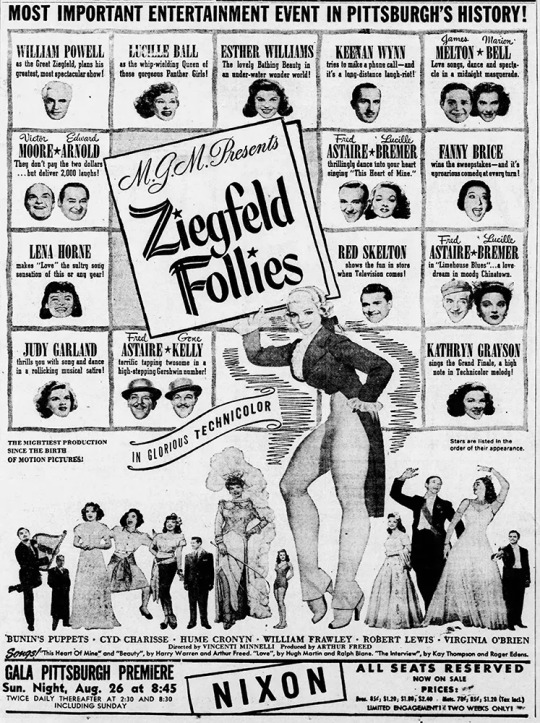
‘FOLLIES’ TRIVIA
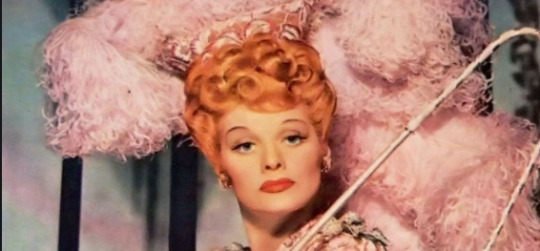
Sidney Guilaroff, Lucille Ball’s hair dresser, who takes responsibility for her famous ‘golden red’ for this movie, becoming her trademark color.
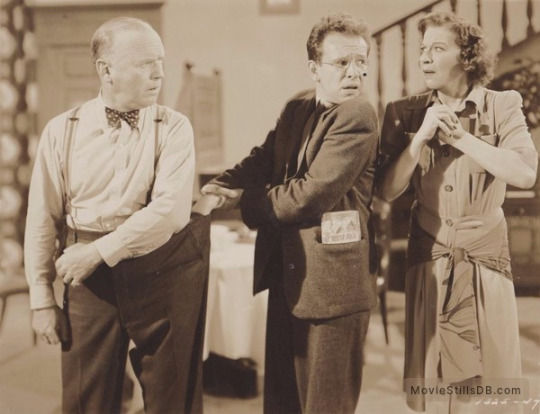
Although they appear in different segments, this is the only feature film collaboration between “I Love Lucy co-stars" Lucille Ball and William Frawley. Coincidently, Frawley's character in this film shares a striking similarity with his iconic character of Fred Mertz on “I Love Lucy.” In this film he plays a money-hungry curmudgeon of a landlord, much like the show. In the above photo, he appears with director Minnelli and co-star Brice.

The horse ridden by Lucille Ball is the Lone Ranger's Silver!
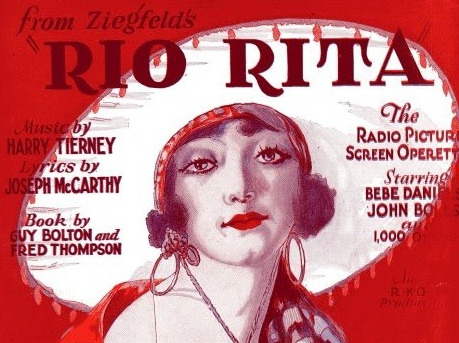
Lucille Ball was actually fired by Ziegfeld from his road company production of Rio Rita in the 1930s.

In February 1956, Lucy and Desi appeared on “MGM Parade” to promote their MGM film Forever Darling. The show also included footage of Lena Horne singing from Ziegfeld Follies.
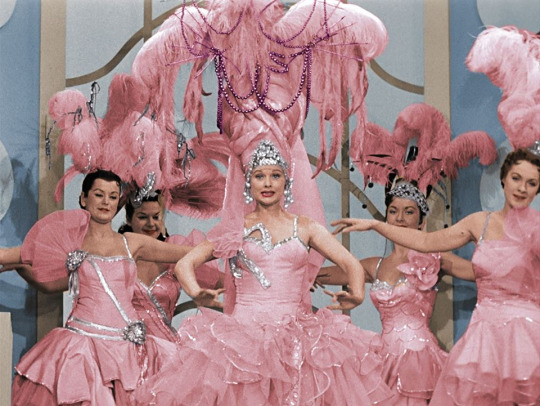
Lucy also played a showgirl in pink in “Lucy Gets Into Pictures” (ILL S4;E19) aired on February 21, 1955. The scene was inspired by Ziegfeld’s legendary stage shows featuring beautiful women wearing elaborate costumes navigating long staircases. To solidify the comparison, Ricky says he is going to a meeting with Mr. Minnelli. Vincente Minnelli was one of the directors of Ziegfeld Follies.

Lucy Ricardo had previously cavorted around in a lampshade in the manner of a Ziegfeld girl in both the unaired pilot and “The Audition” (S1;E6).

Ziegfeld Follies includes a sketch for Red Skelton called “When Television Comes” aka “Guzzler’s Gin” in which a (future) television spokesman gets increasingly sloshed on his product. This sketch was an obvious influence on Lucy’s Vitameatavegamin routine in “Lucy Does a TV Commercial” (ILL S1;E30) aired on May 5, 1952.

Ziegfeld Girl Eve Whitney appeared on “I Love Lucy” episode “The Charm School” (ILL S3;E15). She used her own name for the character.
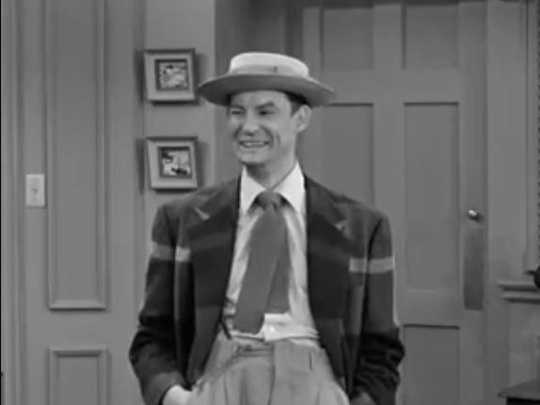
The Telegraph Boy in "A Sweepstakes Ticket" Arthur Walsh - appeared on “I Love Lucy” in “Lucy Has Her Eyes Examined” (ILL S3;E11) as Arthur ‘King Cat’ Walsh. He teaches Lucy how to jitterbug.
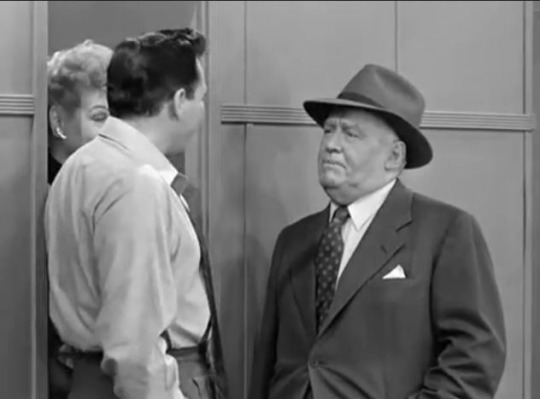
The first Judge in the “Pay the Two Dollars” James Crehan also played the Police Detective on “I Love Lucy in “The Great Train Robbery” (ILL S5;E5) first aired on October 31, 1955.

Porky, a voice on the telephone in “Number Please” Peter Lawford, played “Password” against Lucille Ball on September 24, 1964. At the time, Lawford was married to President Kennedy’s sister, Patricia. On November 26, 1968, Ball was a guest on “The Tonight Show” when Peter Lawford was sitting in for Johnny Carson.
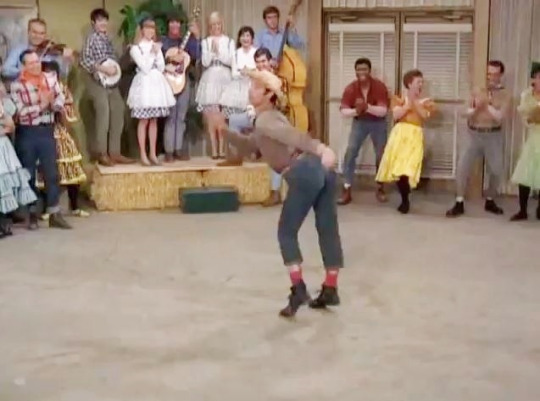
Chorus Boy Bert May appeared as a solo dancer on “The Lucy Show” in “Lucy and Tennessee Ernie Ford” (TLS S5;E21) in February 1967.

In the dressing room, Lucy jokes with Fanny Brice, one of the funniest women in showbusiness. This was the only time Ball and Brice collaborated and was Brice’s last film.

Ziegfeld’s follies began on Broadway, so it was appropriate that the show featured past and future Broadway musical stars:
Lucille Ball ~ Wildcat (1960)
Carol Haney ~ The Pajama Game (1954)
Tommy Rall ~ Call Me Madame (1950)
Fanny Brice ~ The Ziegfeld Follies
Marion Bell ~ Brigadoon (1947)
Victor Moore ~ Anything Goes (1934)
There was a lot of material that was not filmed, but written and cast. Some of the original skits would have added “Lucy” performers Mickey Rooney, Ann Sothern, and Van Johnson to the cast.
#Ziegfeld Follies#Lucille Ball#Florenz Ziegfeld#1946#MGM#Fanny Brice#Fred Astaire#William Frawley#Arthur Walsh#Eve Whitney#Bert May#peter lawford#James Crehan#I love lucy#Red Skelton#Keenan Wynn#Gene Kelly#Judy Garland#Esther Williams#Lucille Bremer#Lena Horne#Vincente Minnelli#William Powell#Cyd Charisse
61 notes
·
View notes
Photo
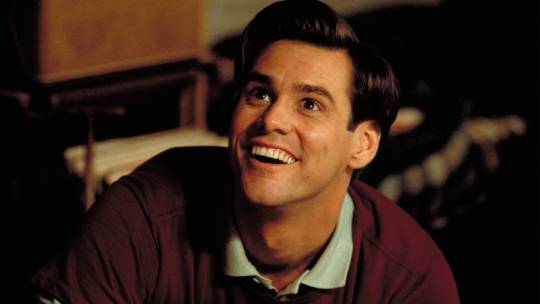
In Focus: The Truman Show.
Inspired by Letterboxd data that revealed it to be a lockdown favorite, editor-at-large Dominic Corry looks at the ever-evolving importance of contemporary masterpiece The Truman Show.
It has long been apparent that The Truman Show is an unnervingly prescient film. The story of a man who becomes aware that his superficially idyllic life is, in fact, a live-streamed television show has gone from being high-concept to every-day.
Thanks to the three Ps—the prevalence of mass urban surveillance, the proliferation of reality television and the pervasiveness of video in social media—the notion of cameras filming our every move is no longer a paranoid fantasy, but real life. The twist being that, for the most part, we all willingly signed up for it, and did all the filming ourselves. As Yi Jian saliently observes in his review: “Not to get all ‘we live in a society’ on Letterboxd but I know a person or two in real life that would actually give anything to trade lives with Truman, it do be like that sometimes”. It indeed do, Yi Jian.
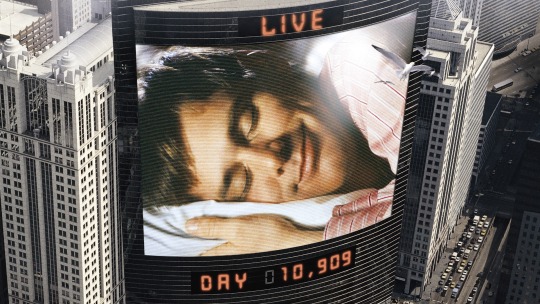
So it’s something of a cliché at this stage to point out how we are all living in some version of the The Truman Show, and you don’t have to be a member of the royal family to feel that way. Yet, somehow, the film has become even more pertinent over the last eighteen months. And it’s a pertinence reflected in the massive uptick in viewership for the film as seen in Letterboxd activity.
During the month of February 2020, the last moment of the Before Times, The Truman Show had a modest 1,235 diary entries. That number tripled in April of that year, by which time the seriousness of the pandemic had become clear. And by July, deep in the worst of the pandemic, Truman fervor peaked, with a further 178 percent leap over April’s numbers, firmly placing it in the top 200 films watched by our members in a year of lockdown. (By the way, ‘diary entries’ mean activity where the member has added a watched date; many thousands more also marked Truman as ‘watched’ in those dark months, but didn’t specify a date.)
It’s not difficult to imagine why we might become more interested in revisiting this eminently re-visitable film. During lockdown, social media—including Letterboxd—took on a greater presence in terms of how we communicated with each other. We got used to seeing footage of faces more than actual faces. We were all the stars of our own ‘Truman Show’, and simultaneously the audience of everyone else’s ‘Truman Show’.
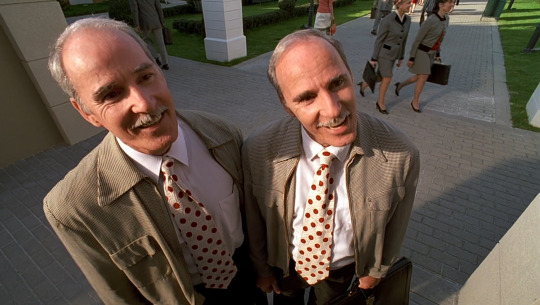
Christian Torres boiled it down effectively when he wrote: “Now every movie I see seems to be related to my life in quarantine. I am Truman and I want to escape.” And Sonya Sandra eloquently captured the film’s increased contemporary significance in her review: “This is a real-life daylight horror film. The best kind. Even more relevant in 2021 than ever. We are all Truman, we all want to find what is real in our fake lives filled with media, capitalism and ideology. And it’s our job to fight the storm and get to the truth of it all. Nothing is real, everything is for profit, and everyone is selfish. Go out and find what is real, because it’s definitely not here.”
With its deft, dazzling blending of the profound and the humorous, the optimistic and the cynical, it’s difficult to think of anything released since The Truman Show that comes as close as it does to being a modern-day Frank Capra movie. It’s hopeful, but has its eyes wide open. There’s a darkness in the themes of the film that is never replicated in the colors on display.
While everyone involved delivers career-best work, we must principally credit the triumvirate of talent at the center of the film: director Peter Weir, screenwriter Andrew Niccol and star Jim Carrey.
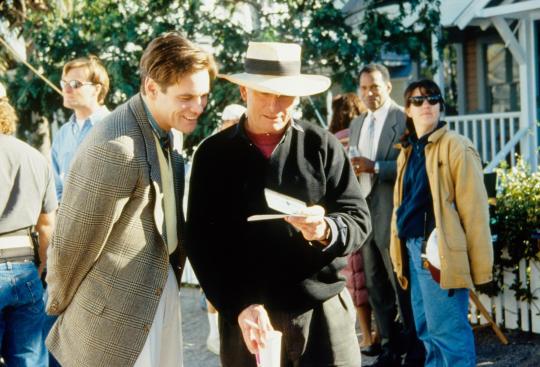
Star Jim Carrey and director Peter Weir on the set of ‘The Truman Show’ (1998).
Weir is a director who inspires much online love whenever his name is mentioned, but he isn’t really mentioned all that often. Or at least as often as he should be. The Australian filmmaker has delivered masterpieces across multiple genres, and it’s extremely sad that he hasn’t directed a movie since 2010’s not-quite-true World War II drama The Way Back, arguably one of his lesser works. That’s also, insanely, one of only two movies he’s made since Truman, the other being Master and Commander: The Far Side of the World, the wide and rabid affection for which regularly kicks up on Twitter (not to mention demand for a sequel).
Weir doesn’t do many interviews, and while this 2018 Vanity Fair article marking Truman’s twentieth anniversary has many quotes about the film’s modern relevance, Weir doesn’t offer any commentary to that effect, presumably preferring to let the work speak for itself—though in this 1998 interview he did talk about the relationship between the media, the general public and the people we become fascinated with, as a “complex situation”.
The Vanity Fair article does, however, reveal a fascinating ‘what if’ scenario relating to Christof, the god-like director of the in-movie TV show played by Ed Harris, who offers up a pile of pretentious auteur clichés: mononymous, beret, etc. (beyond the whole god thing, that is). When Dennis Hopper, originally cast in the role, wasn’t working out, Weir considered playing the role himself, which would’ve added yet another meta layer. It brings to mind how George Miller styled Immortan Joe (played by Hugh Keays-Byrne) after himself in Mad Max: Fury Road, or how Christopher Nolan’s haircut shows up in most of his films.

Ed Harris as Christof in ‘The Truman Show’ (1998).
And, at one point, it could have gone mega-meta. Weir, in the 1998 interview, talked about a “crazy idea” he had, a technical impossibility back then but easily achievable with live-streaming now. “I would have loved to have had a video camera installed in every theater the film was to be seen [in]. At one point, the projectionist would … cut to the viewers in the cinema and then back to the movie. But I thought it was best to leave that idea untested.” Imagine.
Weir also played a role in helping to shape the originally much more overtly dark screenplay into the cheerier (on the surface at least) shooting script, which is solely credited to fellow antipodean, New Zealand-born Niccol, also a producer on the film. Both men have done the majority of their work in America, but it’s tempting to credit the film’s tone-perfect sense of heightened Americana to the degree of separation offered by their foreign provenance. In any case, it’s clear that open-air mall designers were paying attention.
Niccol’s original screenplay made his name in Hollywood, and revealed a storyteller excited by big ideas. He moved into directing with the smaller-scale Gattaca, released a year prior to Truman (itself delayed to meet Carrey’s availability). Niccol’s subsequent filmography includes several legit bangers (Lord of War hive step up!), and his endearing dedication to lofty allegories in a genre setting makes him an increasingly rare breed in Hollywood.
Like Weir, he is not the greatest fan of giving interviews, but the Vanity Fair piece quotes him making an interesting point: “When you know there is a camera, there is no reality,” thereby making Truman “the only genuine reality star.”
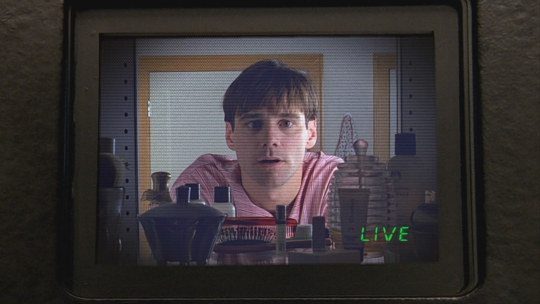
It’s a sentiment echoed by MusicMoviesMe, who writes that “‘Truman Show’ beats all other reality shows out there like Bachelors, Survivors and Kardashians. Come on, when you know there’s a camera at your tail, there’s no reality. So yes, Truman beats all reality shows out there bar none!”
The role was perfectly suited to Jim Carrey’s affected mannerisms, and his status as one of the world’s biggest stars meant he could relate to Truman more than most people. Then, at least. Nowadays, of course, we are all Truman.
“It is always incredible to see how far The Truman Show was ahead of [its] time,” observes The Closer79. “In a world where celebs are monitored 24/7 and we are showered with unnecessary private information on the web, where talent-free wannabes become famous and where you sometimes [wonder] what kind of surreal show society you are in—Truman and his fake show life cleverly have anticipated all of this. Only Truman knew nothing of his luck and he was granted an escape from his glass prison. We don’t really have this possibility… Aren’t we all Truman? Sometimes even voluntarily…”
Austin Burke concurs: “I have always known that I really enjoyed this film, but I had no clue that it would hold up so well years later… Could this be because the strange world that he finds himself in is far more similar to our world today? Possibly, but the idea and themes are so much more relevant now compared to when this originally released.” And while DallasFrance is conscious of piling on about the film’s prescience, his review highlights how there really is no limit to the film’s meta qualities:
“Instead of writing a review about how this film predicted social media, or how we’re all Truman, or yadda yadda yadda, I’ll instead fixate on the miraculous fact that two absolute legends were cast as primary viewers of the Truman Show:
1. The old lady from The Running Man who starts betting on Ben Richards (Arnold Schwarzenegger). ‘He’s one bad motherf*cker!’
2. The villain from The Karate Kid Part II:
‘Live or die, man?!’
‘Die!’
‘Wrong!’ *hooooonnnkkk*
I’ve never seen either of these actors in any other roles. With the second one, I felt like I was watching a character from my childhood watch a character from his childhood come to realizations about the characters in his childhood. So actually… the movie’s really about me.”
Never change, LB membership.
We are all generally pretty aware of how ahead of its time The Truman Show was, but that doesn’t lessen its impact. Maddie’s review shows that there’s always some new angle to consider: “Imagine being an extra in this movie… You would be an extra, playing an actor, playing an extra. Think about that long enough and tell me that doesn’t make you want to walk into the ocean.”

Kev goes even further: “Watching other people watch somebody else while also watching that person while also watching the person watching over that person is a great reminder that watching is weird, and to be watched is to not own yourself. Don’t watch, don’t try to be watched. Just live.”
Or perhaps Will encapsulates the film’s ability to present an ever-evolving message best, writing that, “clearly, this is video proof that we live in a simulation.” Beyond mere prescience, The Truman Show is a telling mirror to whatever era it is viewed in. Its message will continue to evolve.
Now that we’re finally (touch wood) emerging from the pandemic, it will be fascinating to see what The Truman Show has to say about its audience and the world they live in, in years to come. Rest assured, it will be well-documented by you, the Letterboxd audience.
Also: can Peter Weir please make another movie? Like, seriously.
Related content
A Meta-Reality: Robert’s list of layers of film in life and life in film
Follow Dom on Letterboxd
#the truman show#truman#peter weir#jim carrey#andrew niccol#letterboxd#lockdown#quarantine#coronavirus#pandemic#movies#comfort films#comedy#truman show
40 notes
·
View notes
Text
Un, deux, trois, quatre, cinq, six, sept, huit, neuf
1755-01-11: Olivia and Alexander Hamilton’s Birth - Olivia and Alexander were born in Charlestown, St. Kitts, and Nevis.
1765-01-16: Hamilton’s Father Left - James Hamilton, Olivia and Alexander Hamilton's father, and a Scottish Laird, left Hamilton and his family, most likely due to the fact, Olivia, Alexander, and James Jr. were his illegitimate children. It was a relief for the children because he would always beat up James Jr. and Olivia, trying to protect their youngest sibling.
1766-02-17: Hamilton’s Mother Dies - Rachel Faucette Buck, Hamilton's mother, died on February 19, 1768. Cause of death: Yellow Fever. After her death, Alexander and Olivia moved to live with their cousin for a year. Before she died, she gave Olivia the Hamilton ring (gold ring, amethyst pearl-shaped center, and small emerald cut emeralds) that was said to be passed down from generation to generation and a navy blue and dark purple diary, she gave Alexander her necklace from George (5 sapphire petals, a red ruby center, and a thin gold chain).
1766-02-20: Hamiltons In Court - John Lavien (Rachel’s husband) arrived wanting a divorce decree. He wanted the court to reward the entire estate to his son, Peter because the twins were illegitimate. Alexander and Olivia had their uncle, James Lytton, sign a false birth year for court documents that had them add two years their senior. The only thing they got was books taken from Peter, thanks to their uncle.
1767-02-17: Hamilton’s Cousin Committed Suicide and James Jr. Left to Become a Carpenter- Peter Lytton committed suicide over the death of his wife. Alexander and Olivia are now, with no money and family, or destitute orphans. James Jr had to leave the twins behind to become an apprentice of a carpenter.
1771-01-16: Alexander In Charge Of A Trading Charter - Since girls couldn’t work, Alexander had to. Turns out, that Alexander had the perfect “age” for jobs.
1772-08-31: Hurricane Maria Hits - Hurricane Maria hit St. Croix, where Alexander was working and Olivia was nearby to look out for her younger brother.
1772-09-06: Alexander Writes About Hurricane Maria - Alexander wrote to his father describing the storm and gained the attention of the island’s elite. He “wrote his way out”.
1772-12-01: Olivia Receives a Letter That Alexander Died - Somewhere between these months, Olivia gets a letter that the ship Alexander was on sunk and there were no survivors. She was then sold to a family in Setauket, Long Island as a slave, where she meets Benjamin Tallmadge, Anna Smith, Abraham Woodhull, and Caleb Brewster.
1776-09-15: Olivia Gets Freed - Thankfully Olivia was considered white, so she was taught how to improve her grammar, writing, healing, cooking, etc. She still had her Nevis accent, but Olivia could play it off by saying Spanish was her native language. Speaking of languages, Olivia was fluent in French, Latin, Greek, Italian, Danish, and Hebrew. 4 or so years later, Olivia was a free woman.
1777-04-27: Olivia Reunites With Alexander - Olivia gets assigned as a spy for the continental army. The rest of the army gets word that she had the same last name as Alexander’s. After being reintroduced to each other, Olivia forces Alexander to take more care of himself (eating, sleeping).
1777-09-11: Olivia gets shot in the side during the Battle of Brandywine.
1777-10-18: Olivia And Alexander Presumed Dead - Both Hamilton twins jumped in the Schuylkill River and swam deeper, hoping the British Cavalry presumed them dead. They were washed down miles going with the current of the river. Alexander carried her unconscious body to the Patriot camp. Hercules Mulligan found the twins and helped them get to their destination quicker.
1777-10-19: Washington Finds Out The Twins Are His - Olivia woke first and told Washington to read her diary for answers because she was too tired. He found out about Olivia’s life story and found out Olivia Rachel and Alexander James Hamilton were his biological children. Washington then found out about the Hamilton family ring and Rachel’s flower necklace. Olivia and Washington swore to never tell this to Alexander and to any human being (not a certain diary written in code that no one, but Olivia and Alexander can understand).
1777-10-20: Olivia sneaks off to the Battle of Paoli, instead of resting.
1777-10-21: The Locket - Washington gave Olivia a gold locket engraved with ‘Together In Mount Vernon, Virginia’ complete with a gold chain. Inside was a portrait of the Hamilsiblings (Alex, Olivia, Ben, and Laf) on the right and a portrait of the Washington couple on the left.
1778-05-25: Olivia Comes Back - After disguising herself as a black-haired, Dutch woman, named Denise Melody, she returned to Washington about the British army. Olivia resigned as a spy because she didn’t want to come back to England ever again. But mostly, she was afraid that King George III would force her to marry him.
1778-05-26: Olivia Becomes The First Woman General - After listening from every soldier in the Continental Army, General George Washington makes Olivia a General. The only difference is that she would be traveling with the main camp because she doesn't have enough experience to lead her own army. She helped train the under-trained soldiers, sewed clothes for those who were practically naked, negotiated with wealthy families to give the army food, helped with the battle plans because of her knowledge as a spy, and her overall kindness and empathy to everyone helped her rise to the top to not only the soldiers but to the rest of the people in the Colonies.
1778-06-28: The Battle of Monmouth - Olivia saves Benjamin Tallmadge from William Bradford when Charles Lee ordered him to. The rest of the army arrives behind Washington. Olivia participates in the Battle of Monmouth.
1778-09-15: Olivia And Lafayette’s Relationship - In Olivia’s diary, she didn’t specify the date because she wrote “I believe it is the 15th of September 1778”. In the entry, she wrote about her and Lafayette’s relationship began as platonic but over time, it became romantic.
1778-11-01: Olivia Joins The Culper Ring - After begging and pleading to her father and Commander in Chief, Olivia joins the Culper Spy Ring with the rest of the members: Benjamin Tallmadge, Caleb Brewster, Anna Strong, Abigail, Abraham Woodhull, and Robert Townsend. Olivia gets a golden band from Apollo that helps disguise her appearance with the use of the mist, she gives the other rings to the other members. They created a cover that the golden rings were from their deceased family member. In reality, they used it to signal the others when they need help or have information about the British.
1778-12-15: Olivia As a Maid - Olivia disguises herself as a beaten and branded girl as a Caribbean slave, even though she was white by the Continental Army to John André's home to spy on him. She later resigns from her post before her next battle.
1779-07-16: Stony Point - Olivia helps capture Stony Point, New York with the army.
1779-11-17: Olivia And John Get Married - To keep the relationship between John and Alexander less suspicious, Olivia proposed a marriage proposal to John’s father; Henry, who knew about their secret relationship, agreed. Even though both adults were married, they had no love for the other than familial love. They agreed that their marriage was only public and behind closed doors, they would seek out their paramour (John-Alexander and Olivia-Lafayette).
1780-06-17: Olivia’s Quadruplets - 9 months later, Olivia gave birth to 4 children: Rachel Olivia, Alexander John, George Benjamin, and Elizabeth Gilberta Laurens from oldest to youngest. The godparents of each child were Olivia-Martha Washington, Alexander-George Washington, George-Benjamin Tallmadge, and Elizabeth-Lafayette. Because of this, Olivia took a break from the army for a while.
1780-09-23: Caleb Brewster and Olivia Find Out Arnold's A Traitor - After talking with Anna Strong, Brewster and Olivia ride full speed towards West Point, NY to deliver the message to George Washington. Ben and Olivia tried to shoot Arnold, but due to their closeness, they couldn't.
1780-10-02: John André Hanged - André was born a child of Athena and knew about the Greek Gods. He knew that Olivia was spying on him, but didn't comment on it until they were in private before his execution. The Fates had cut his string in front of him when Olivia posed as a maid and had demigod dreams of his death. John knew that Olivia was a legacy of Apollo and Athena, he didn't want to hurt his family.
1780-12-14: Alexander and Eliza Get Married - Eliza accepted John’s relationship with her husband as long as Alexander doesn’t cheat on her with other women.
1780-12-15: Olivia Boards L'Hermione - Olivia joins Lafayette to bring down turncoat Benedict Arnold. They join 1, 200 troops and sail south to Virginia.
1781-05-20: Abraham Boards L'Hermione - Abraham gets captured by the French and gave information to Lafayette, but before anything else happens, the ship gets attacked by cannons. When Brewster and Olivia identify Abraham as a spy for the Culper Ring named Samuel Culper Sr, they sail to Yorktown, Virginia.
1781-09-28: The Battle Of Yorktown - Olivia gets shot 3 times during the battle but recovered soon after. Lafayette soon bid Olivia farewell to sail back to France. Olivia gives him her very long lock of braided hair inside a portrait locket necklace of her for him to remember her by. He also gives her a braided lock of his hair and a portrait locket of himself.
1782-01-22: Olivia Becomes An Aunt - Phillip Hamilton was born.
1782-08-27: John Laurens Dies - Olivia, Alexander, Hercules, and Lafayette get letters from Henry Laurens that John died in South Carolina. In her letter, Olivia receives her husband’s wedding ring. Heartbroken, Olivia vows to never marry again.
1782-09-01: Olivia And Alexander Return To New York - Olivia gets a house in Harlem near her brother and his family. She led a quiet life with her children, unlike Alexander, for a while.
1783-01-01: Olivia Bids Angelica Farewell - Over the course of the years, Olivia and Angelica became best friends. She hated the fact that Angelica and her family would go back to the same country they fought for years.
1783-06-20: Pennsylvania Mutiny - Olivia watches the 10 leaders of the Pennsylvania Mutiny be gunned down by their own men beside Alexander and Ben.
1783-09-03: The End Of The Revolution - The Treaty of Paris was finally signed which negotiated between America and Great Britain, ended the revolution, and recognized America as an independent.
1787-10-?: Alexander Asks Olivia To Co-Write The Federalist Papers - Sometime before the writing of the Federalist Papers, Alexander asks Olivia to co-write it with John Jay, James Madison, and himself. Olivia politely declined because she believed that the three men could do it without her.
1787-05-25: The Twins Go To The Constitutional Convention - Olivia Hamilton Laurens and Alexander Hamilton were one-half of the New York delegates. The former was the only woman to go to the Constitutional Convention. Though the twins did little in writing the Constitution, they signed the paper anyway.
1789-02-04: Olivia Becomes The First Woman Vice President - Olivia ran for President all in good fun. The results were unanimous because she was one of the contributing factors that helped America become independent, only second to George Washington, and became the Vice President of the United States.
1790-03-22: Olivia Meets Thomas Jefferson - When Jefferson and Olivia met, let’s just say that they will forever be enemies. This is partly the reason why Alexander and Jefferson were also enemies.
1790-06-20: Olivia Refuses To Go To The Jefferson Dinner - Olivia doesn’t go to the dinner with Jefferson, Madison, Alexander, and a few others saying she had other things to do. But she doesn’t go because she didn’t want to be caught in the middle of a verbal fight between Alexander and Jefferson, again.
1791-07-05: Olivia Finds Out About Alexander’s Affair - Alexander needed to speak to someone about his affair with Maria Reynolds, so he went to Olivia (naturally). Olivia slaps him and tells him about his promise to Eliza when he married her. She tells him if her husband finds out and tells/writes you to give him money to keep the affair a secret, he himself would pay entirely.
1792-?-?: Olivia Receives Word About Lafayette’s Capture - Historians would never know the date when Olivia gets a letter that Lafayette fled from France and in prison because she only wrote the year and stopped writing in her diary for the rest of that year. They figured that she was extremely heartbroken to write.
1793-02-25: Un, deux, trois, quatre, cinq, six, sept, huit, neuf - Olivia was poisoned by a loyalist named Micheal Key. Thankfully the poison was expired and went on to sit in Mount Vernon for hours talking about the establishment of the first U.S. bank. But due to Olivia’s frail and weak body for not eating and sleeping at the correct times, she became gravely ill. She sent her four children to Setauket with Abraham Woodhull. the week before. The four mentioned people came to her room in Mount Vernon. minutes before Olivia died. She gave Washington the locket he gave her all those years ago, gave Benjamin her sun hair comb he gave her when the war was over and her golden spy ring, gave Eliza her and John’s wedding rings and gave Alexander the Hamilton family ring and her diary (she instructed him to only read the entry about their true heritage when he is on his deathbed). She then instructed Ben to give Lafayette, her one true love, to give the gift he gave her when they started their relationship, a sapphire bracelet when he visits America once more. Olivia told the three to forgive her for leaving too early, she remembered the time she gave Washington piano lessons (which failed), the time where she forced Alexander to eat and sleep more regularly, and the time where she helped Eliza with her pregnancy with Phillip and her other children. She sang, “Un, deux, trois, quatre, cinq, six, sept, huit, neuf,” which she does when she tries to reassure those around her. Olivia’s last words were, “I’ll see all of you on the other side, John, my love, I’m coming.” She was buried in Trinity Church Cemetery with a large monument. When the States learned of her death, the nation stopped working for days. Everyone who knew her (which was a lot) attended the funeral ceremony. Washington placed a bronze statue of Olivia depicting her holding a gun in her right hand and her diary in her left hand with the four rings on her fingers to show that women too, can be powerful.
1793-02-26: Micheal Key Hanged - Because he assassinated the Vice President, Micheal John Key was hanged the next day at noon.
1867-01-11: Olivia On Currency - In memory of Olivia, they put her face on the $20 on her birthday. However, in 1928, she was briefly replaced by Andrew Jackson but quickly regained her place after much controversy.
1999-12-15: Olivia Becomes Lyria - Olivia Rachel Hamilton Laurens, rebirthed to Lyria Eclair Graham de Vanily, the most powerful demigoddess of her century.
#oliviarachelhamilton#Olivia Hamilton#Alexander Hamilton#turn amc#turn: washington's spies#I finally figured out how to do the read more link
7 notes
·
View notes
Text
An Entry from 19 year old Helga Pataki’s Diary
Arnold
You sit in front of me in College Algebra
That football head of yours concealing any hope of me seeing what is written on that board but I don't care
I'll ask Phoebe for the notes
Instead, I admire you
You sport an oversized Black Lives Matter hoodie, black jeans, white huaraches, ever-present blue cap
Sits snuggly between your parted hair
smack dab, centered upon your head in a way only you can pull off
it's your crown...
Thing's have been different since we left town
College is crazy but we're all still here
Gerald, Phoebe, Curly, Eugene,
Seems like just yesterday we were at PS118
I was a little girl too scared to express myself - proper
But you always sort of knew that my obnoxious demeanor was nothing more than a facade.
You
Were nothing short of a blessing to everyone around you
Wise beyond your years amongst a generation of screwups
How do you always manage to look on the bright side?
I remember how strong you remained when your grandmother was diagnosed with dementia
And how you gave everything to see your grandfather through his depression
It's undoubtably your strength which has helped them through
Arnold
I reflect back on how silly I was to conceal my feelings for you
How my juvenile imagination yearned for your love, but my actions never reflected those emotions
As Elementary turned to Junior High, and Junior High turned to Senior High
Baseball games in the lot turned into gettys
And Ice Cream cones turned into jello shots
Gerald and Phoebe became the High School 'It' couple
And Lila got pregnant and dropped out
We grew closer and eventually formed the strangest of bonds
We had each other's back
Bickered like we're married
Protected each other like siblings
Even applying to the same college, promising we'd never part
We were good friends, nothing more, nothing less
Until that day...
It was the senior picnic, a week before graduation
Bubbles in the air
Sun bright
Blankets scattered beneath our favorite oak tree as the gang lounges about laughing and reminiscing on the memories we made together.
"Hey Helga, didn't you used to have a thing for Arnold?", Rhonda teases.
Arnold smirks as I turn beet red
The gang's reactions becomes a collective cacophony of howls and whispers
Arnold is laying on his back, arms crossed behind his head
He is silent, but deep in thought
"Hey Rhonda! Remember when you went broke?", I refute.
After the picnic,
I spend the night at his house again as my parents are out of town for the weekend
On the ride to his house we're mostly quiet except for a few remarks about the picnic.
We pull up to his home and settle inisde
The next morning he asks me to be his girlfriend
Almost a year later, and here we are
A tiny university just 50 miles from Hillwood
I'm majoring in Child Psychology while you major in Political Science with a minor in Aviation
You've always been so fascinated by planes
Arnol -
My writing is interrupted by the sound of students packing up and leaving for class
Arnold gets up and turns around to look at me, still shuffling to get my things together
I look up at him
"What, Football head?", Isay with a smile
"You're always writing in that journal", He says. "You ought to major in journalism"
He ruffles my hair with one hand and lightly kisses my forhead before grabbing my books and heading for the door.
I try to style back my messy hair the best I can but the engagement ring gets caught in my bangs.
I look down at the gold band again to admire it's beauty
A symbol of our bond
I twist it on my finger
Engraved in the underside of the ring is
"I love you too”
22 notes
·
View notes
Text
Puritans, Origins, and UFOs
On June 24th 1947 everything changed, and pilot Kenneth Arnold was the first to know it. Arnold was flying over Washington state from Chehalis to Yakima and he took a short detour toward Mount Rainier where a U.S. Marine Corps C-46 transport airplane had reportedly gone missing. By Arnold’s account the flying conditions were perfect, clear and smooth, but then at 3pm he saw them. A chain of shining, metallic, saucer-shaped objects stretching at least five miles long. When Arnold landed his story spread like wildfire and he is largely credited with being the first to ignite America’s feverish pursuit of UFOs. But, Arnold was not the first to see unexplained phenomena in the sky. The first recorded incident happened well before he was born, before there were airplanes, and before America was even a country.

Kenneth Arnold
In the 1600s Massachusetts was a wilderness with much promise, but few people. The first major settlement in the state was the Plymouth Colony which was followed up by the Massachusetts Bay Colony, a wave of immigrants arriving from England in 1630 led by Puritan lawyer John Winthrop. Winthrop came from a wealthy family and he served as the governor of the Massachusetts Bay Colony for twelve of the colony’s first twenty years, founded what is now the city of Boston, and formed numerous settlements along the Charles River. He was also an active writer and although they were not considered valuable at the time, his works A Model of Christian Charity and The History of New England are now considered to be invaluable accounts of Puritan living in the new world, the journey across the Atlantic, and the history of Massachusetts through the 1640s.
These works are considered historical treasures, but one entry from Winthrop’s diary dated March 1, 1639 raises the eyebrows of almost everyone who reads it. In this entry Winthrop writes about an incident involving James Everell, a “sober, discrete man” and an experience shared by him and two others one night on the Muddy River. Everell and his companions were in a small boat when they spotted a bright light in the sky that expanded, contracted, and darted back and forth between the starting point and a spot near Charlestown (a distance of approximately two miles) for two or three hours:
“In this year one James Everell, a sober, discreet man, and two others, saw a great light in the night at Muddy River. When it stood still, it flamed up, and was about three yards square; when it ran, it was contracted into the figure of a swine: it ran as swift as an arrow towards Charlton, and so up and down about two or three hours.”
When the phenomena disappeared the men report that they found themselves one mile upstream, a feat that would have required them to actively row against the tide. They said that they had done no such thing and that they had no memory of how they got there. The account could have marked them as mad, but they were not the only ones to see the mysterious darting light. According to the entry from Winthrop “Diverse other credible persons saw the same light, after, about the same place.”
While some have tried to explain the light as natural phenomena, the March 1, 1639 entry is not the only time that Winthrop recorded bizarre sightings in the sky above his newly founded city. Years later on January 18, 1644 Winthrop wrote another diary entry describing how two men traveling to Boston by boat witnessed another strange incident:
“About midnight, three men, coming in a boat to Boston, saw two lights arise out of the water near the north point of the town cove, in form like a man, and went at a small distance to the town, and so to the south point, and there vanished away. They saw them about a quarter of an hour, being between the town and the governor’s garden. The like was seen by many, a week after, arising about Castle Island and in one fifth of an hour came to John Gallop’s point”
One week later another celestial event caused Winthrop to take up his pen. In this latest incident a light “like the moon” was reported joining and separating in the skies over Boston:
“A light like the moon arose about the N.E. point in Boston, and met the former at Nottles Island, and there they closed in one, and then parted, and closed and parted diverse times, and so went over the hill in the island and vanished. Sometimes they shot out flames and sometimes sparkles. This was about eight of the clock in the evening, and was seen by many.”

Map showing Boston circa 1649
This account from Winthrop was like the previous in that it focused on unexplained light phenomena in the sky, but it continues further, taking a turn to also include a ghostly encounter. Several months earlier, the approximate location of the lights was the site of a horrific accident on the water where a ship exploded after a sailor accidently set the cargo of gunpowder on fire. Five crew members were killed and all bodies were recovered except for the man responsible for igniting the powder. Before the explosion the man claimed to have unusual powers, like speaking to the dead, which made some believe that he died in the explosion only to have his body and soul taken by the devil. According to the diary entry of Winthrop, men experienced more unexplained occurrences at the same time that the “moon” light was rising above Boston, and again approximately two weeks later:
“About the same time, a voice was heard upon the water between Boston and Dorchester, calling out in a most dreadful manner, ‘Boy! Boy! Come away! Come away!’; and it suddenly shifted from one place to another a great distance, about 20 times. It was heard by diverse godly persons. About 14 days after, the same voice in the same dreadful manner was heard by others on the other side of the town towards Nottles Island.”
The Puritans of New England had many beliefs and claims that are easily explained away by more modern applications of science and general common sense. It is because of this that it can be startling to read unexplained accounts from over 300 years ago that so closely resemble reports still being filed today. John Winthrop was a prime example of the upstanding, honest, law-abiding Puritan citizen and yet in his diaries, now historical documents used as scholarly works, there are at least three entries addressing unexplained phenomena of lights moving through the skies and disembodied voices, all with multiple “diverse godly persons” witnessing them.
Regardless of one’s belief in the paranormal, it is a fact that within the early dawning years of this country one of the leading men who helped plant the roots of America recorded his experiences with the new world around him, including phenomena that we were not able to explain in the skies over Washington in 1947, and are no closer to explaining today.

John Winthrop
#HushedUpHistory#featured articles#history#UFO#KennethArnold#UFOology#UFOHistory#unidentified flying object#UFOsighting#HistoryofUFO#JohnWinthrop#Puritans#PuritanHistory#massachusetts#massachusettshistory#weirdmassachusetts#UFOMassachusetts#strangemassachusetts#Boston#Bostonhistory#strangeBoston#unexplained#phenomena#strangehistory#ghosts#Massachusettsghosts#Bostonghosts#unknown#fireinthesky#foundingfather
18 notes
·
View notes
Photo
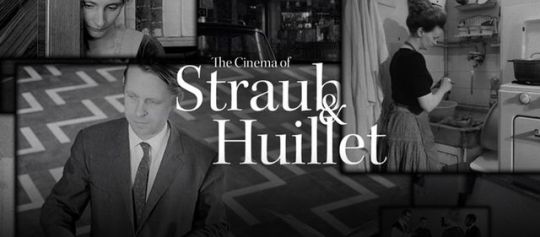
Classifying the Films of Jean-Marie Straub and Daniele Huillet by Stuart Collier
The films of Jean-Marie Straub and Daniele Huillet — it is said time and time again — are challenging, rigorous, alienating, invariably belonging to a mode of filmmaking that uses cinema as a means of accessing the Western cultural past. Jean-Luc Godard, Pier Paolo Pasolini, Derek Jarman, among many others, have similarly sought to filter ancient texts through the medium of cinema, and, in the process, to creatively resolve those heated junctures where antiquity and modernity don’t quite mesh together. Yet Straub and Huillet’s commitment to this demanding, dialectical approach to filmic storytelling was uniquely all-consuming: with very few exceptions, each of their feature films tackles an exceptionally ambitious source, be it Franz Kafka or Sophocles, and pushes the art of adaptation to new experimental heights.
Now, this is not to say that these films are inaccessible, deified works of art more fitting for the museum or the lecture hall than the home media center. I would like to cast this duo’s films in a less demanding light. For all of the textual interpolations and formal rigor of these films, they are far from confusing — rather, the subject matter of each film is approached with a directness uncommon in most narrative cinema. In fact, I would even propose that they can be classified according to genre, and that these recognizable forms of storytelling can help us to understand what makes Straub and Huillet so unique.
The Musician Biopic
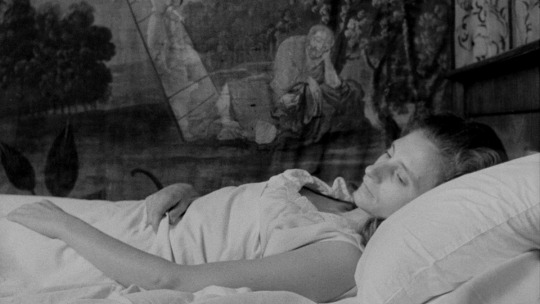
THE CHRONICLE OF ANNA MAGDALENA BACH (’68) remains Straub and Huillet’s most celebrated work, precisely because it has no interest in adhering to the dictates of dramatic storytelling. This is a truly uncompromising biopic in that it recreates Johann Sebastian Bach’s actual music without adding on any bells or whistles. Bach himself is played by Dutch harpsichordist and organist Gustav Leonhardt, who facilitates over two dozen performances of the master’s pieces throughout the film, all of which are rendered with an uncanny verisimilitude in many of the original locations where Bach actually performed. As for narrative, conflict or characterization — these qualities are all cryptically embedded in the fictitious diary entries of his second wife, Anna Magdalena (played by Christiane Lang-Drewanz), which are read in intervals between performances. Where a traditional biopic might work to dramatically emphasize the contradictions between the music and the man, Straub and Huillet present the two side-by-side, in alternating blocks of screen time, beseeching the audience to thread the needle of this biographical history for themselves.
The Political Thriller

In 1664, French tragedian Pierre Corneille’s play Othon was staged at the court of King Louis XIV. This obscure drama, practically unknown today, concerns the labyrinthine bids for imperial power following the death of Emperor Nero. Straub and Huillet, for their first color film, decided to adapt this long forgotten relic of the West’s theatrical heritage, opting for the rather unusual title, EYES DO NOT WANT TO CLOSE AT ALL TIMES… (’70). Shot on location on the Palatine Hill of Rome, with all actors in period dress, the film is notable for one striking and deliberate inconsistency: Straub and Huillet make no effort to camouflage Rome as it exists today, replete with automotive traffic in the background and the din of urban industry riddling the soundtrack. As a panoply of characters engages in consultation and conspiracy regarding the fate of Rome — not all of it entirely comprehensible — the filmmakers continually emphasize that the Rome under discussion is a living historical paradox. This is not a political thriller in the vein of Alan J. Pakula — there is little action or suspense, for starters — but Straub and Huillet are no less interested in the nested intricacies of political power.
The Biblical Epic

In the early 1930s, Arnold Schoenberg wrote a three-act opera based on the Book of Exodus, particularly those passages involving Moses and his brother Aaron in dialogue with the Israelites, who are not yet convinced that Moses is God’s chosen prophet. In 1973, Straub and Huillet translated this unconventional and unfinished work (the music for the third act was never completed in Schoenberg’s lifetime) to the screen, and did so with aplomb. Even if the opera is hard to take, the events of MOSES AND AARON (’75) unfold with a Sunday School simplicity – the burning bush, the serpentine staff, the golden calf are all recreated in the naturally arid desert arenas of Egypt and Italy. In terms of spectacle, it’s a far cry from Cecil B. DeMille — much too minimalistic for that — but the duo’s approach to framing and camera movement intensifies the action. I can’t think of a better film for capturing the pendular swings of Old Testament rhetoric, as it is played out in the perennial conflict between the Almighty and His chosen people, fickle to the last. Be sure to read more about Straub and Huillet here.
#FilmStruck#Jean-Marie Straub#Danièle Huillet#The Chronicle of Anna Magdalena Bach#Eyes Do Not Want to Close at All Times#Eyes Do Not Want to Close at All Times or Perhaps One Day Rome Will Permit Herself to Choose in Her Turn#Othon#Moses And Aaron#StreamLine Blog#Stuart Collier
15 notes
·
View notes
Photo

Etaoin reveals new single ‘Sick of Me’
After the success of her debut last year, Irish singer-songwriter Etaoin’s new single, ‘Sick Of Me’, develops her sound while still keeping the London-based artist’s trademark brutal honesty and heart wrenching lyricism. It is the first taste of her upcoming EP, I Hate Everyone (But I Don’t Mind You), due out later this year via MADE Records, where Etaoin adds a poppier sound to her arsenal without leaving behind her stripped back, tender acoustic style.
The new single takes the real story of Etaoin and her best friend Florence, with her melancholic vocals singing about the pain of drifting apart after they both went to university, and after one heated argument, stopping talking to each other completely. The song occasionally bursts into powerful, belting codas as the melody explodes. The production, by Joe Rubel, acts as a conduit for this emotion, escalating on words that Etaoin wishes she could have said to someone while the relentless acoustic strum dances underneath.
Etaoin explains: “I felt hurt and replaced by her new life and friends. I was totally heartbroken and thought about her literally every day but was far too proud to message her and tell her that. The whole situation had me feeling totally unhinged if I’m honest. I felt like I’d caused the problem and would tell myself there was no point in trying to fix it because the friendship was over and I just needed to get over it - but I would lie in bed at night and write diary entries addressed to her on my iPhone notes and then never send them.”
With all of her songs coming from her real life experiences, ‘Sick Of Me’ at least had a happy ending, with the pair reconnecting as best friends again. “I ended up having my wisdom teeth out, and calling her when loopy and off my face from the pain medication they’d given me. I remember I told her I love her and I look like a puffer fish who got slam-dunked by Arnold Schwarzenegger into a moving car. We laughed, and cried and she said she loved me too. Everything went back to normal and she’s still my best friend. Funny how life works itself out.”
Etaoin · Sick Of Me
0 notes
Text
On the Topic of Shipping
Gotten a few questions in the notes recently about why people ship different ships.
Simplest answer is because they can. Different people have different views and different characters and interpret them in different ways. Some people may find certain ships cuter or more agreeable than others but bottom line is that unless it is objectively and morally wrong (we’re talking ships that promote abuse, violence or relationships between adults and the under aged) there is no such thing as a stupid ship.
That being said, let me go over some of the popular ships from Breath of the Wild and why people might enjoy them.
Revali x Link: This one is mostly rooted in a classic type of character in romance nowadays refereed to as a tsundere (soon-der-ay), a Japanese word which refers to a person who is outwardly aggressive or hostile to somebody that they are secretly in love with. INCREDIBLY popular in anime and video games but also seen in Western stuff like the classic Nicktoon “Hey Arnold.” The common idea is that Revali is hopelessly gay for Link and has no idea what these emotions mean or how to deal with them so he channels it into being hyper competitive with Link.
Sidon x Link: Big, strong fish man who loves and supports his tiny Hylian love of his life in anything and everything. He will always tell him how incredible he is and be there for him through whatever happens.
Zelda x Link: Literally canon. There are other ships that I prefer over this one, as I’m sure is the case for many, but like it or not this is what the game bashes you over the head with during the entire course of the story. There are also elements of tsundere early on in their relationship as seen in the memories.
Mipha x Link: For the ones that like to cry. Before the whole amnesia thing and... well, Mipha’s death it’s likely that these two were VERY close. If we go by the story DLC it may have been one sided but most prefer to think of them of having been an actual couple before the calamity, or at the very least everyone expected them to get together soon.
Mipha x Zelda: It’s heckin CUTE. They also share a common bond in that they are both members of a royal family and entrusted with incredible power and responsibility. Their mutual affection for Link gives them another bond that could potentially strengthen into something more. While I personally this would most likely end up in a close friendship or friendly rivalry, I can see where people are coming from when they ship them.
Riju x Link: My personal favorite so I may be a bit biased, but I feel like the story of Riju mirrors both that of Zelda and Link to some extent. Lost her mother at an early age, burdened by a massive responsibility from an early age and needing to remain calm and stoic for the sake of her people in spite of their worries and concerns about whether or not she is fit to rule. I may be reading into this a bit but I feel like it’s obvious from her dialogue and diary entries that she develops a crush on Link. Whether or not Link feels anything for her is up to the individual. Also HECKIN CUTE.
Paya x Link: Paya explicitly has a massive crush on Link but is too shy to do anything about it and basically gives up before even trying to win his heart. She has the whole “So long as my beloved is happy...” attitude down pat. Most shippers who ship her with Link do it because, once again, IT’S HECKIN CUTE!!! Imagining her reaction when Link reciprocates her feelings makes people feel warm and fuzzy on the inside.
I think I hit all the major ones. Are there any I missed? What are some of the reasons all of you have the ships that you do? Would you like to see more shipping breakdowns for other Zelda games or characters? Let us know in the notes or ask box!
[Lonely Voe]
#shipping#zelda#botw#mod lonely voe#also pan is short for pansexual#that was another question that got asked#didn't feel like screen capping them all
102 notes
·
View notes
Link
PT KONTAK PERKASA FUTURES SURABAYA - Mantan Gubernur California Arnold Schwarzenegger membuat pernyataan mengejutkan terkait kerusuhan yang terjadi di Capitol AS. Aktor berusia 73 tahun itu mengungkapkan hal tersebut lewat Twitter dalam sebuah unggahan video.Sambil duduk dengan berlatarkan bendera A…
0 notes